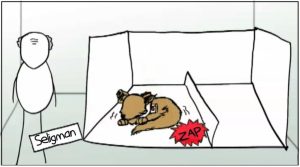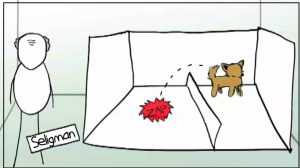What is Learned Helplessness?: Martin Seligman accidentally came upon the concept of learned helplessness. Initially he experimented on dogs, hearing the sound of a bell and receiving a shock. The research was intended to observe how a dog reacted after the sound of a bell, yet before receiving a shock. Regardless, the bell sound and the shock were unavoidable in this experiment. The dogs were then experimented on in another procedure and were mixed with other dogs who did not undergo the first procedure as described above. This experiment, however, involved an avoidable shock. Each dog could jump from one side of a fence to the other and avoid a shock. The dogs who had not been through the “unavoidable shock experiment” did just that: they leaped to avoid the shock. But the dogs who had the experience of several unavoidable shocks previously, had learned wrongly that their efforts to avoid pain were fruitless. They laid down and depressively received the shocks. They were not helpless, but they had learned that they were.

Learned Helplessness
Learned Helplessness and Humans: We can develop learned helplessness and the resulting depression too. First we have experiences which are unpleasant, distressing or painful. After these experiences, we may attribute them as external or internal, stable or unstable, local or global (Abramson, Seligman & Teasdale, 1978). Applying this to the loss of employment, we see the following:
| Personal | |||
| Internal | I lost this job because I am incompetent, worthless, and a failure. | External | I lost this job because It was a difficult job and my boss didn’t like me. |
| Permanent | |||
| Stable | I’m incompetent and I will always be incompetent. | Unstable | I didn’t work hard enough or train enough; however, I can improve on these. |
| Pervasive | |||
| Global | I will perpetually lose jobs. This is my lot in life. | Local | This job loss is unfortunate, but it is just one job. |
Someone who attributes the lost job to factors in the right side will likely give up trying. Not only is there no point in trying when you know you will fail, but the experience of failure itself is unpleasant and just adds to the pain—so this person likely thinks. This is learned helplessness in action.
On the right side you have a very different way of looking at things: Failure can be utilized as a mechanism for growth and improvement. Failure is not internalized as proof of one’s inherent worthlessness.
Avoid & Change Learned Helplessness: How can you change thinking from the left side to the right side? It’s not always easy, but it can be done. Here are some things that can help:
- Encouragement. Encouraging people in a genuine way regarding the constructive things they have done. Encouragement regarding progressive improvement is one of the best ways to do this!
- Training and Education. Not just training and education, but training and education in ways where learners can learn well and according to the ways they learn best (sometimes hands-on rather than just book learning).
- Exceptions. Helping people recognize and remember times when they have succeeded before and it was great! Nobody fails 100% of the time and nobody succeeds 100% of the time.
- Support. Support can mean family, friends, or other professional support to help people find solutions to their problems and make progress toward their goals.
Sited:


